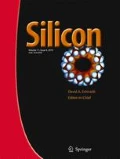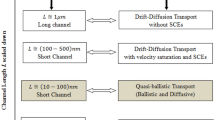Abstract
A simplified analytical approach within the framework of Landauer-Buttiker formalism has been employed to model the drain current in a ballistic n-channel metal oxide semiconductor field effect transistor (MOSFET) and the expression for the device threshold voltage has been obtained. To achieve ballistic operation the said MOSFET has been modeled considering low temperature (77 K) and intrinsic silicon channel for electronic motion of the charge carriers. The model incorporates quantum confinement effect, drain induced barrier lowering (DIBL) and short channel effects (SCE). Further, the effects due to surface scattering and back scattering are included in this model to obtain a near ballistic behavior. The current-voltage characteristics are compared with the available experimental results and are found to be in reasonable agreement.
Similar content being viewed by others
References
Datta S, Assad F, Lundstrom MS (1998) The silicon MOSFET from a transmission viewpoint. Superlattices Microstruct 23(3):771–780
Assad F, Ren Z, Vasileska D, Datta S, Lundstrom M (2000) On the performance limits for Si MOSFET’s. IEEE Trans Electron Devices 47(1):232–240
Baksh SS, Sarin RK, Amin SI, Anand S (2018) Design of gaas based junctionless field effect transistor and its performance evaluation. J Nanoelectron Optoelectron 13(1):32–37
Natori K (1994) Ballistic metal-oxide-semiconductor field effect transistor. J Appl Phys 76:4879–4890
Ren Z, Venugopal R, Datta S, Lundstrom M, Jovanovic D, Alamos L (2000) The ballistic nanotransistor: a simulation study. In: IEDM: 4–7
Knoch J, Lengeler B, Appenzeller J (2002) Quantum simulations of an ultrashort channel single-gated n-MOSFET on SOI. IEEE Trans Electron Devices 49(7):1212–1218
Lundstrom M (1997) Elementary scattering theory of the Si MOSFET. IEEE Electron Device Lett 18(7):361–363
Lundstrom M, Ren Z (2002) Essential physics of carrier transport in nanoscale MOSFETs. IEEE Trans Electron Devices 49(1):133–141
Natori K (2008) Compact modeling of ballistic nanowire MOSFETs. IEEE Trans Electron Devices 55(11):2877–2885
Bose SC, George PJ, Shekhar C (2005) Evaluation of device parameters of HfO 2 /SiO2 /Si gate dielectric stack for MOSFETs. In: Proceedings of the 18th international conference on VLSI design held jointly with 4th international conference on embedded systems design : 0–5
Noor A, Shekhar C (1996) A 3D analytical model for threshold voltage of small-geometry MOSFET. Solid-State Elecrron 39(5)
Dennard RH, Gaensslen FH, Rideout VL, Bassous E, LeBlanc AR (1974) Design of ion-implanted MOSFET’s with very small physical dimensions. IEEE J Solid State Circuits 9:256–268
Frank DJ, Dennard RH, Nowak E, Solomon PM, Taur Y, Wong HSP (2001) Device scaling limits of Si MOSFETs and their application dependencies. In: Proceedings of the IEEE 89(3): 259–288
Wong HSP, Frank DJ, Solomon PM, Wann C H J, Welser J J (1999) Nanoscale CMOS. In: Proceedings of the IEEE 87(4): 537–570
Baccarani G, Wordeman MR, Dennard RH (1984) Generalized scaling theory and its application to a ¼ micrometer MOSFET design. IEEE Trans Electron Devices 31(4):452–462
Koleva Mirella V, Slavcheva G (2017) Handbook of optoelectronic device modeling and simulation1st edn. Taylor & Francis
Richards RD, Mellor A, Harun F, Cheong JS, Hylton NP, Wilson T, Thomas T, Roberts JS, Ekins-Daukes NJ, David JPR (2017) Photovoltaic characterisation of GaAsBi/GaAs multiple quantum well device. Sol Energy Mater Sol Cells 172:238–243
Hareland SA, Kzlshnamurthy S, Jallepalli S, Yeap CF, Hasnat K, Tasch AF, Maziar CM (1996) A computationally efficient model for inversion layer quantization effects in deep submicron N-channel MOSFETs. IEEE Trans Electron Devices 43(1):90–96
van Dort MJ, Woerlee PH, Walker AJ, Juffermans CAH, Lifka H (1992) Influence of high substrate doping levels on the threshold voltage and the mobility of deep-submicrometer MOSFET’s. IEEE Trans Electron Devices 39(4):932–938
Krisch KS, Bude JD, Manchanda L, Manchanda L (1996) Gate capacitance attenuation in MOS devices with thin gate dielectrics. IEEE Electron Device Lett 7(11):521–524
Sichi T, Toriumi A (1995) Quantitative understanding of inversion-layer capacitance in Si MOSFET’s. IEEE Trans Electron Devices 42(12):2125–2130
Khan SUZ, Hossain MS, Hossen MO, Rahman FU, Zaman R, Khosru QDM (2014) Analytical modeling of gate capacitance and drain current of gate-all-around InxGa1-xAs nanowire MOSFET. In 2014 2nd Int Conf Electron Des ICED 2014: pp 89–93
Rahman A, Guo J, Datta S, Lundstrom MS (2008) Theory of ballistic nanotransistors. IEEE Trans Electron Devices 50(9):2846–2858
Yu B, Wang L, Yuan Y, Asbeck PM, Taur Y (2008) Scaling of nanowire transistors. IEEE Trans Electron Devices 55(11):2846–2858
Wu Y, Member S, Su P (2009) Analytical quantum-confinement model for short-channel gate-all-around MOSFETs under subthreshold region. IEEE Trans Electron Devices 56(11):2720–2725
Numata T, Uno S, Nakazato K, Kamakura Y, Mori N (2010) Analytical compact model of ballistic cylindrical nanowire metal-oxide-semiconductor field-effect-transistor. Jpn J Appl Phys 49(4S):04DN05-01–04DN05-06
Kushwaha M, Chatterjee AK, Prasad B (2016) Gate tunnelling current model for nanoscale MOSFETs with varying surface potential. IETE J Res 62(3):347–355
Kushwaha M, Chatterjee AK, Prasad B, Chatterjee AK (2014) Generalized analytical approach for estimating the wavefunction and gate tunneling current in a nanoscale MOSFET. In 2014 2nd IEEE international conference on emerging electronics (ICEE)
Chatterjee AK, Prasad B (2018) Analytical model of gate to channel capacitance for nanoscale MOSFETs. IETE J Res:1–9. https://doi.org/10.1080/03772063.2018.1510746
Ganin E, Sai-Halasz GA, Wordeman MR, Kern DP, Rishton S (1988) High transconductance and velocity overshoot in NMOS devices at the 0.1- mu m gate-length level. IEEE Electron Device Lett 9(9):464–466
Wordeman MR et al (1987) Design and experimental technology for 0.1-μm gate-length low-temperature operation FET’s. IEEE Electron Device Lett 8(10):463–466
Kim R, Lundstrom M (2011) Notes on Fermi-Dirac integrals (2011). https://arxiv.org/abs/0811.0116
Stern F (1972) Self-consistent results for n-type Si inversion layers. Phys Rev B 5(12):4891–4899
Natori K (2008) Ballistic/quasi-ballistic transport in nanoscale transistor. Appl Surf Sci 254:6194–6198
Colinge JP (2008) FinFETs and other multi-gate transistors. Springer Science+Business Media, LLC, New York
Tsuchiya H (2008) Influence of elastic and inelastic phonon scattering on the drive current of quasi-ballistic MOSFETs. IEEE Trans Electron Devices 55(9):2397–2402
Natori K (2002) Ballistic MOSFET reproduces current–voltage characteristics of an experimental device. IEEE Electron Device Lett 23(11):655–657
Acknowledgments
Authors would like to thank Prof. P. N. Ram, Department of Chemical Engineering, M. J. P. Rohilkhand University, Bareilly, India for his interest in the work. We acknowledge the facility and support provided by the Department of Electronics and Communication Engineering, Thapar Institute of Engineering and Technology, Patiala, India and the Department of Electronic Science, Kurukshetra University, Kurukshetra, India.
Author information
Authors and Affiliations
Corresponding author
Additional information
Publisher’s Note
Springer Nature remains neutral with regard to jurisdictional claims in published maps and institutional affiliations.
Rights and permissions
About this article
Cite this article
Chatterjee, A.K., Kushwaha, M. & Prasad, B. Analytical Model for Drain Current of a Ballistic MOSFET. Silicon 13, 1777–1785 (2021). https://doi.org/10.1007/s12633-020-00574-3
Received:
Accepted:
Published:
Issue Date:
DOI: https://doi.org/10.1007/s12633-020-00574-3




